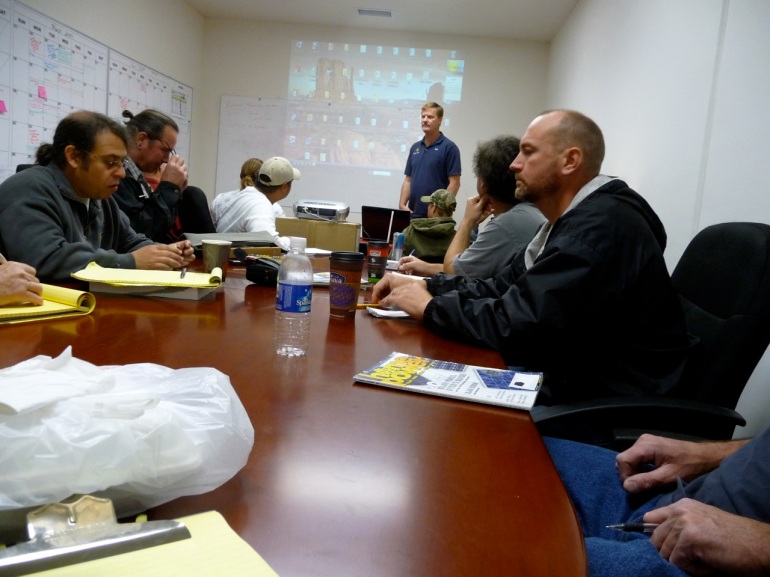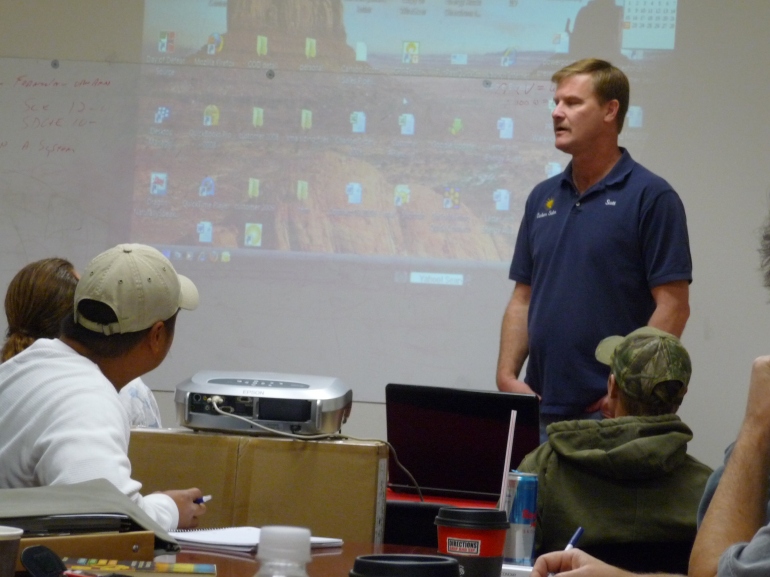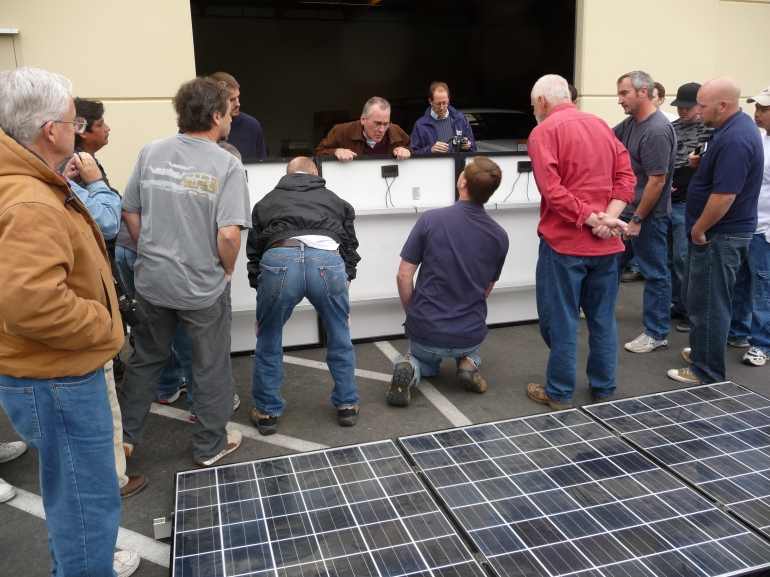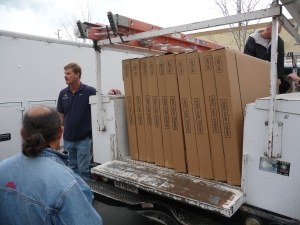I have to admit that for the first few hours of day one in PV101: Introduction to Photovoltaics I was dazed and confused by all the foreign concepts I was trying to grasp at once. I wasn’t feeling very Creative or very Greenius. I was feeling mostly dumb ass.
 Understanding Ohm’s Law of resistance, the basics of current, amps and volts, not to mention the concepts of alternating current, Kirchhoff’s Circuit laws and the many fun equations that spell it all out – if you happen to read and understand those hieroglyphics – had me feeling pretty damn ignorant and out of my element.
Understanding Ohm’s Law of resistance, the basics of current, amps and volts, not to mention the concepts of alternating current, Kirchhoff’s Circuit laws and the many fun equations that spell it all out – if you happen to read and understand those hieroglyphics – had me feeling pretty damn ignorant and out of my element.
The extent of my electrical background heretofore consisted of installing lighting fixtures and new wall switches – so long as they were replacements for existing items that got wired the same way.
Now my head was swimming with concepts of Joules, Coulombs and electrons all dancing about in the mysterious ways they create electricity.
And I was quite certain that of the 25 or so other guys in the room, every single one of them knew a hell of a lot more about the electrical basics than I did.
 Our group was an interesting and friendly mix of unemployed construction workers looking for new careers; electricians, iron workers and other licensed contractors looking to expand into solar installation; and three or four guys who were there to learn how to do a self install of solar for their home, shop or cabin. I was surprised – and disappointed – that no women had signed up for the classes.
Our group was an interesting and friendly mix of unemployed construction workers looking for new careers; electricians, iron workers and other licensed contractors looking to expand into solar installation; and three or four guys who were there to learn how to do a self install of solar for their home, shop or cabin. I was surprised – and disappointed – that no women had signed up for the classes.
Luckily for me once we got past the conceptual to the nuts and bolts of designing, installing and wiring a solar system, Scott boiled down all the math to the essential Amps x Volts = Watts, and even taught us what amps, volts and watts are. How cool is that?
And even more fortunate for me, and the rest of the guys in the class, Scott Carlson, was teaching our class because Scott went light years beyond the course description and the PowerPoint from the Solar Living Institute to add his own lessons from 22 years in the business and over 1000 installs.
 Scott has a passion to share what he knows and to answer every question that’s asked – which means our class learned about twice as much as we might of with any other instructor. I felt like what we got from Scott Carlson was the golden ticket class that only the luckiest students found themselves in. Who deserves that more than me?
Scott has a passion to share what he knows and to answer every question that’s asked – which means our class learned about twice as much as we might of with any other instructor. I felt like what we got from Scott Carlson was the golden ticket class that only the luckiest students found themselves in. Who deserves that more than me?
Time after time Scott would would offer us the “by the book” lesson and then add his personal experience lessons with working examples from his on-the-job history. The professional perspective and tips we got was like a taste of interning with the master.

I’ve got a lot more to learn, but what a great total immersion the three consecutive eight hour sessions were, especially since I made the journey with the Reverend Ron and we booked rooms at the local Holiday Inn Express so we could feel even smarter. Besides the Rev’s splendid company, there was the added benefit of the buddy system of learning since we spent our post class time discussing what we had learned each day in class, not to mention the 2 hour drive home.
- Prospective installers to enter the PV job market
- Contractors looking to add PV systems to their client offerings, or to specialize in them all together
- Property owners considering the purchase of a PV system who need unbaised information prior to collecting bids from contractors.
 By “utility interactive” they mean what’s commonly called grid-tied solar. That’s a PV system that’s connected to the same electric grid you currently get your electricity from.
By “utility interactive” they mean what’s commonly called grid-tied solar. That’s a PV system that’s connected to the same electric grid you currently get your electricity from.
For me that’s Southern California Edison (SCE), for my friend Melonie in L.A. that’s the Chinatown movie star DWP, and for my buddy Richard up in San Francisco it’s PG&E.
The interactive part of the system is the way your solar panels feed power into the grid when they’re generating more electricity than your house is using and the way you draw energy from the grid when its dark and your solar panels aren’t making any electricity – or when you’re using more electricity than your solar is generating during the day.
When you hear talk about how your meter spins backward with solar, the dial literally does spins backward (at least the old nondigital kind does) when you’re feeding electricity back into the grid and it spins forward again when you’re drawing electricity from the grid.
If your system isn’t grid-tied, meaning you’re literally “off the grid” then it needs to be battery-based so you can store the energy you generate during the day to use after the sun goes down. You can add a battery back up system to your grid-tied solar system but most folks don’t choose to do so.
With a battery system you lose voltage during the whole process of transferring it and storing it in the batteries which makes those battery-based systems less efficient. That’s one why most people don’t add batteries to their grid-tied systems unless they’re in unreliable/remote areas.

A grid-tied PV system is a lot less complicated, is easier to install and takes far less maintenance than a battery-based system and grid-tied was what we were there to learn, but that’s not all Scott Carlson, our instructor, wanted to teach us. So we learned about battery-based systems too and the parallel wiring required to connect it – not to be confused with the series wiring used to connect grid tied systems.
What’s the difference between series and parallel wiring you’re asking? As I learned, series wiring is negative to positive or positive to negative if you prefer (except for the home runs). Wiring in series increases the voltage. Parallel wiring is about increasing the amps and involves connecting positive to positive and negative to negative.

Then there’s the string sizing, which is a big part of properly designing how your system is wired. You wire panels in series strings in order to get the total voltage up to the 240 volts needed for most inverters. Fortunately the different stringing options are offered on inverter manufacturer’s web sites. These sites let you plug in all your system info and then tell you what size strings you can use – like three strings of ten panels, or two strings of eight panels or any number of other combination. Scott took us through several scenarios and system examples until we all understood how it works.

We also learned quite a bit about proper site surveying and the optimal conditions for locating the panels, about using Google Earth to find true north as opposed to magnetic north and about a whole bucket full of other handy, highly useful sites on-line to help with every step along the way
Roof safety, ladder tips and safety harness awareness were part of the program as were lessons on semiconductor technology and the difference between monocrystalline modules, multicrystalline or polycrystalline modules and thin film.
 A lot of my friends have heard of thin film solar and think maybe that would be the best choice for their roofs, but unless you have a really big roof it’s probably not going to work the way you think it will.
A lot of my friends have heard of thin film solar and think maybe that would be the best choice for their roofs, but unless you have a really big roof it’s probably not going to work the way you think it will.
While it’s true that thin film recently broke the $1 a watt barrier, it’s considerably less efficient than mono or polycrystalline modules and you’d need about twice the space.
So it’s perfect for warehouse and commercial building applications, but it won’t generate enough total watts of power in the space allowed on my roof.
You might also think, as I did going into the class, that places like Palm Springs, Phoenix or the hottest parts of the desert are the most perfect places of all for PV solar, but solar panels work best if they don’t get too hot, so places with lots of sunshine, but a nice cool breeze blowing to keep air flowing around and under the panels is actually better for the best efficiency.
We learned about roof pitch and ideal inclination strategies. We learned how to avoid inter-row shading of panels when multiple rows are installed. I discovered what Azimuth is and understood the difference between Standard Test Conditions (STC) and PV USA Test Conditions (PTC) – the latter are more real world. Who knew? Now the Solangelist does.
We learned about the negative impact of shading on even a small portion of one panel in a string and what we learned is that each string is only as strong as its weakest link. That’s one area where those cool little Enphase microInverters come in so handy, but I digress…

We learned about using the Solar Pathfinder, long a standard tool of the solar industry for solar site shade analysis and we also learned about the newer and easier to use Solmetric SunEye with its built in digital camera and more sophisticated measurement software.

Lucky for guys like me, all of today’s solar panels come with nifty, idiot-proof male and female connectors that look like this:

Of course we also learned how to make our own custom length whips and home runs, stripping wire to add and then crimp the special connectors. Those home runs that go to combiner and junction boxes need to be inside metal conduit that we learned to bend and shape using the  bending tool familiar to all electrical workers.
bending tool familiar to all electrical workers.
The wiring from the roof all winds up going into a DC disconnect box and then into your inverter to get changed into AC before heading into your home’s main breaker panel. After that it’s just like the electricity you’ve been using from the electric company all these years.
Part of your job installing solar panels is being an electrician and another part is being a roofer because every solar panel goes on a rack and mounting system. First you’ve got to cut roof tiles and drive lag bolts into the rafters, then you’ve got to install the flashing and struts that the rails go on. You need to do all that without damaging any part of the roof too which takes special steps and care.
The panels themselves go on the rails and get attached to the rail with clips that get bolted down.
 The whole racking system needs to get grounded too, usually with bare copper – but that’s back to electrical work. You’ve also got to ground the modules to the racks but you do that using stainless steel Weeb grounding clips. Of course, not every town will approve the Weeb clips, so you best check with your city’s rules first…
The whole racking system needs to get grounded too, usually with bare copper – but that’s back to electrical work. You’ve also got to ground the modules to the racks but you do that using stainless steel Weeb grounding clips. Of course, not every town will approve the Weeb clips, so you best check with your city’s rules first…
We didn’t just learn the nuts and bolts of the install process either. Scott started at the beginning, teaching us about the different types of solar panels – or modules as the industry would like us to call them.
We learned about Scott’s history too, which goes back to the 1980’s when it comes to Solar. After graduating from San Diego State University in 1981, Scott began his career as the lead maintenance technician, in charge of the Natural Reserve System Research Facilities for the University of CA Riverside.
Scott quickly realized how PV solar could make his job a lot easier and he began installing and maintaining Solar Electric systems for the remote student research facilities around Southern CA. Soon thereafter he began teaching classes at the local adult school in basic electrical and photovoltaics. He’s been teaching ever since.
In 1997, he started Carlson Solar in Hemet, while still working part time for the University. Scott is a C-10 Licensed Electrical Contractor, is NABCEP certified and he’s got his C-46 Solar License.
Our classes were held at Scott’s new Murrieta office and warehouse facility which was another advantage for us because we spent a good deal of time out in the warehouse getting hands on with the different components of the system instead of just looking at slides of them.
The third day of our classes was PV 102 – Wiring Your Own PV system and that’s what we spent the day doing. First at Carlson Solar’s warehouse where we wired up nine panels and connected them to an inverter to generate some power.
 Then we drove off into the Inland Empire’s ranch and farmland hills where Scott’s company was installing 90- 190 watt Sharp Solar panels in a ground mount installation.
Then we drove off into the Inland Empire’s ranch and farmland hills where Scott’s company was installing 90- 190 watt Sharp Solar panels in a ground mount installation.
It was a battery-based system, quite different from the typical roof based system, but a great learning opportunity for our large group so off we went.
We installed the final dozen panels and wired them in strings getting a good taste of how everything works together.

After we completed that assignment it was back to the warehouse classroom for a final few hours of review and Q&A in which Scott tied it all together and then offered his services as our ongoing mentor, available to answer our questions and help us out when we need him.

Just as good as all the how-to knowledge Scott shared was the ethos he operates by which he also passed onto us. Scott stands by his work pretty much for a lifetime. If something goes wrong with any system he’s installed he will make it right, seemingly no matter how many years later. Scott understands that the best salespeople he can possibly have are satisfied customers who tell their neighbors, friends and family about how great a job he did and what incredible service he offered after the sale.
I really liked that Scott was as intent about passing on his high standards and professional ethics as he was in mentoring us to be equally professional in all the other steps of the job.
I’ll tell you one thing – if you were going to have a solar system installed by a professional, I don’t think you could find a more skilled, more knowledgeable, more proficient or more caring person to do the job than Scott Carlson. After spending three days with the guy I can’t imagine anyone being any better. And the same kind of standards extend to his crew.
I wasn’t the only one who seemed to dig the class. I know the Rev did. And we even met a couple of other students we’ve kept in touch with and are planning on working with on some solar projects in the future – maybe the near future if one of them has his way, since he’s planning on opening his own solar installation company.
Everything I learned from Scott confirmed my belief that the best way for California to start greening our grid at a much faster rate to to rapidly an accelerate adoption of rooftop solar. The technology is ready and the combination of panel price drops, Federal Tax Credits and the California Solar Initiative rebates from the utilities makes the timing perfect.
One impressive fact that stays with me now a month later is that not only are the panels covered by a 25 year manufacturer’s warranty to still be producing electricity after 25 years, but testing shows that they might very well have a useful lifespan ten times that long. So the idea that panels you put on now will become antiquated and no longer generating free, clean renewable power from sunshine is ludicrous.
So the Solangelist left Murrieta fired up, and ready to go ahead with my Raise the Roof plans as well as my plan to install my own solar system before the year is over.
But I also left hungry for more learning and more hands on experience. And I knew just where I wanted to get it – volunteering with Grid Alternatives and installing solar on low income housing.
And so it was that last week I found myself in San Diego taking the Grid Alternatives volunteer training course, once again with the Reverend Ron, but that my solar brothers and sisters is a tale for another Creative Greenius post. In the meantime, check out Grid Alternatives if you’d like to see some folks making a real difference.



Yo Greenius,
Great post – sez it all. (Whatever you do though, don’t say anything about Ron’s Q – that stays with us.)
Greenius,
Thanks Rev. You were there, so you should know. As to Ron’s Q… Ron who? I don’t know any Rons Rev, really.
Just when I think I know it all, I am humbled by the genius of the greenius. We could use such technology and enthusiasm here in Georgia – you Californians consistently pave the way. Go Joe!
Greenius
Well thank you most kindly, Southern lady. I know Georgia is a bit slow, but the same solar PV panels, inverters, racks and mounting hardware and everything else you’d need to generate solar energy is available for the fine people of the Peach State just as it is all others. In fact, New Jersey, which I dare say is no sunnier than your former Confederate bastion, is light years (pun intended) ahead of the home of Hotlanta when it comes to solar installed. Perhaps the Solangelist will have to travel South and East. But I best bring my own water, right? I know you guys have been in a long drought situation… Thanks again for weighing in Elizabeth Ann!
Great post, this should help more people start living off the grid.
Wish we had this much help when we started 15 years ago.
The Chinatown movie star?! No wonder I always feel so slimy when I pay my DWP bill…
What I found really cool, other than everything else you said, was that the panels really might last more than the guaranteed 25 years. I had heard – probably from a sour, drill, baby, drill acolyte – was that the panels would probably need replacing in much less than 25 years because “the technology just isn’t that great.” Thanks for disabusing me of that notion.
I’m ready to sign up to Raise the Roof…
Greenius:
First off, on the DWP/Chinatown reference –
The full story dates back to 1913, when agents for L.A. quietly bought up Owens Valley farms and ranches for their water rights along the Owens River, which drains much of the eastern Sierra. In 1913, the river itself was diverted more than 200 miles south via canal and pipeline. The first aqueduct was built to transport water from Inyo County to the San Fernando Valley, turning the once-fertile Owens Valley into a dust bowl. The events were depicted in the 1974 movie “Chinatown.” Hence the term, “It’s Chinatown, Jake…”
Secondly, regarding how long solar panels last – the amount of bullshit and lies I have heard from people who don’t have a clue what they’re talking about is astounding. For example, their isn’t a single member of the Torrance Environmental Commission or the Torrance City Council, or the Torrance City staff that has a working knowledge or any real experience with PV solar. Or any other kind of solar for that matter. They don’t put in the hours or do the work necessary to be up to speed or have any foundation. The Solangelist intends to help them out big time this Spring.
Such a useful and insightful blog- wow!!!! I can’t believe you do this for free and feature no advertising or spam!
The Greenius: Me neither!
I�m ready to sign up to Raise the Roof�
Greenius:
First off, on the DWP/Chinatown reference �